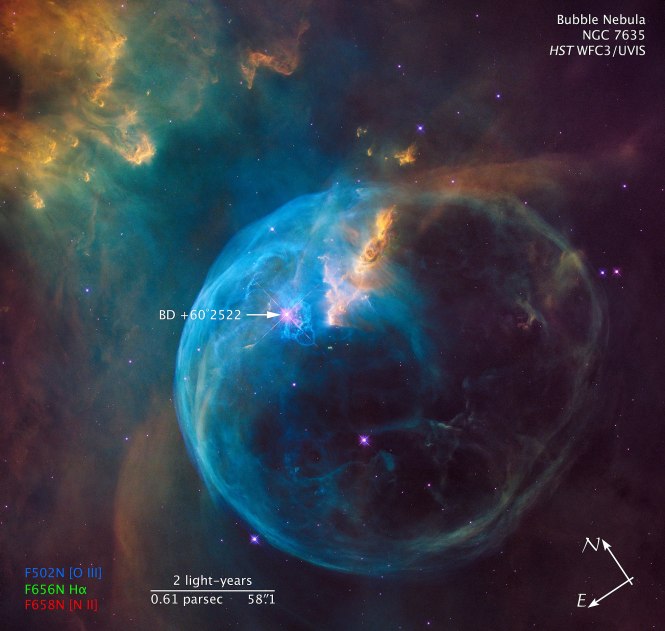For the 26th birthday of NASA’s Hubble Space Telescope, astronomers are highlighting a Hubble image of an enormous bubble being blown into space by a super-hot, massive star. The Hubble image of the Bubble Nebula, or NGC 7635, was chosen to mark the 26th anniversary of the launch of Hubble into Earth orbit by the STS-31 space shuttle crew on April 24, 1990.
What kind of star can create a bubble like that? Although BD+60°2522 is around two million years old, the surrounding nebula is apparently only about 40,000 years old. The bubble is expected to be formed as a shock front where the stellar wind meets interstellar material at supersonic speeds. The wind from BD+60°2522 is travelling outwards at 1,800 – 2,500 km/s, causing the star to lose over a millionth of the mass of the sun every year. The effective temperature of the star is 37,500 K (the effective temperature of our sun is around 5780 K!).

BD+60°2522, the seething star forming this nebula is 45 times more massive than our sun. Gas on the star gets so hot that it escapes away into space as a “stellar wind” moving at over 4 million miles per hour. This outflow sweeps up the cold, interstellar gas in front of it, forming the outer edge of the bubble much like a snowplow piles up snow in front of it as it moves forward.
The gases heated to varying temperatures emit different colors: oxygen is hot enough to emit blue light in the bubble near the star, while the cooler pillars are yellow from the combined light of hydrogen and nitrogen.
Source: hubblesite.org, NASA’s YouTube channel.
Here you can download a huge 58-megapixel TIFF file of Bubble Nebula (94 mb) and read more here about the future of our sun.





This is so cool! Awesome the things that can be found in outer space 😀
LikeLiked by 1 person
Yes, I was absolutely shocked. It’s absolutely beautiful.
LikeLiked by 1 person
Very cool!
LikeLiked by 1 person